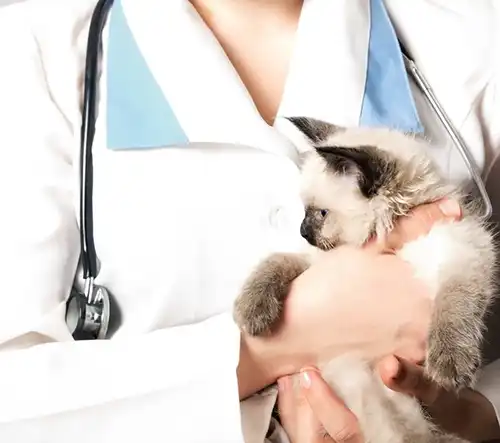When it comes to feeding our furry friends, pet owners often encounter a myriad of common pet nutrition questions. Understanding what constitutes a balanced diet for your pets is crucial for their health and longevity. This article, “Pet Nutrition: Common Questions About Feeding Your Pets,” aims to address these frequent inquiries with clear, evidence-based answers. Whether you’re wondering about the best type of food for your pet’s age or the nutritional needs specific to their breed, we’ve got you covered. From decoding pet food labels to understanding the right portion sizes, we’ll explore the essentials of pet nutrition. By equipping pet owners with reliable information, we hope to empower you to make the best dietary choices for your beloved animals, ensuring they stay happy and healthy throughout their lives.
Do your pets get really, really enthusiastic about dinner? Most of our patients certainly do. While our patients’ perspectives on most topics range greatly, the majority of them agree on one thing: they all like eating and snacking. (Some like it a bit too much, but we’ll save that for later.) Filling Fluffy and Fido’s bowls is easy, but deciding what to put in them can get kind of tricky. This page contains pet feeding recommendations from a Grange Hill East, ON veterinarian.
Making Sense Of Pet Food Labels
One of the most beneficial things you can do is make a habit of reading food labels. This is when things get a little more challenging. Many businesses employ exaggerated marketing techniques to make their items appear better than they actually are.
Stick to products that have acquired AFFCO certification. AFFCO, or the Association of American Feed Control Officials, is a non-profit organization that oversees pet food ingredients, production techniques, and quality standards. They work to ensure that pet food meets the quality standards required to keep your pet healthy, as well as that nutrients are in the appropriate amounts. A mark of approval from them shows that the brand has been thoroughly reviewed.
AAFCO-approved foods must display several critical details on their packaging, addressing common pet nutrition questions:
- Brand name
- Product name
- Name of the animal for whom the meal is intended (cat food, dog food, etc.).
- Quality statement
- Ingredients list
- Feeding instructions
- Analysis. This is an important one because it shows the percentages of nutrients. While some elements can be specified with a maximum percentage and others with minimums, the list must be presented in a specific order and in measured units.
- A declaration of access to nutrients that “indicates that the food is complete and balanced for a particular life stage, such as growth, reproduction, adult maintenance or a combination of these, or intended for intermittent or supplemental feeding only.”
- Name and address of the manufacturer or distributor
Of course, you will want to look for the seal of approval!
Reading Ingredients
The ingredient list may be difficult to navigate, in large part due to labeling rules. For example, if a component appears in a product’s name, it must make up at least 95% of the entire amount. However, there are techniques that corporations use to get around this. Something called ‘flavor’ only needs to have roughly 3% of the element.
Pet food ingredients, like those in human foods, must be mentioned in proportion, with the first item listed taking up the highest percentage, and so on. Look for things with meat, fish, or poultry stated first and foremost.
What Ingredients in Pet Food Should You Avoid?
One of the most crucial factors to examine is what ingredients are in your pet’s diet. Many human and pet foods are highly processed and may contain fillers, preservatives, and other unwanted ingredients. These may be more than just subpar; some may be unhealthy.
Here are some things you should avoid in your pet’s food:
- Propylene Glycol: Propylene glycol,which is commonly used in dog and cat treats, improves food stability. It has also been proclaimed illegal in Europe, which is cause for alarm on its own.
- Thickening Agents: While thickening agents are unlikely to be among the most harmful drugs, they do carry some dangers. Carrageenan, guar, xanthan, and cassia gum are some of the most often utilized. They also offer stability and texture. However, while more research is needed, certain studies indicate that they may be carcinogenic.
- Artificial Food Coloring: Dyes are harmful to your pet’s health. They are frequently used to make the finished product more appealing and uniform for humans. Pets, of course, don’t care how their food looks. Red 40, Yellow 5, and Yellow 6 all contain benzidine, a carcinogen.
- Rendered Fat: Rendered fat may seem sensible. However, it is frequently made by combining and boiling the residual parts of animals that have been processed for meat. Unfortunately, some of the animals might have been sick or injured.
- Corn Syrup/High Fructose Corn Syrup. Corn syrup is used in many processed foods. It has been associated with a variety of human health problems, including cardiovascular disease, diabetes, and fatty liver disease. If it’s bad for us, it’ll most likely be bad for Fido or Fluffy.
- Artificial Preservatives: Some of the most common include butylated hydroxyanisole (BHA), butylated hydroxytoluene (BHT), and ethoxyquin. These can be found in various wet and dry foods, including snacks.
If you have any common pet nutrition questions, reach out to your veterinarian for accurate guidance.
How Should I Choose the Right Food?
The first thing we would suggest is that you contact your vet. While we may go over some basics here, it’s vital to remember that each pet is unique. This decision is influenced by a number of factors, including your pet’s age, health, breed, and lifestyle, as well as any medical conditions they may have. An underweight Pomeranian will have quite different dietary needs than a big Labrador, and a young St. Bernard will require different food than an elderly Chihuahua.
The AFFCO categorizes pet food ingredients and nutrients into several distinct groups.
- Protein: Protein is required for pets’ cartilage, tendons, ligaments, skin, fur, claws, muscle, and blood cells. As it degrades, it produces critical amino acids necessary for your pet’s health and survival. Animal proteins that are commonly used in pet food include chicken, lamb, fish meal, cow, and eggs. Beans, soybean meal, and corn gluten meal are all plant-based proteins often found in pet food.
- Water: Obviously, your pet should have continual access to fresh water. Pet food also contains water. The moisture content of your pet’s food may influence how well they absorb nutrients. Kitties are a fantastic example of this. Cats’ natural food consists of mice and birds. Fluffy also consumes her prey raw, when the moisture content is the highest. As a result, her optimal diet is pretty high in moisture.
- Carbohydrates (including fiber): Carbohydrates give dogs energy in the form of glucose, which is essential for keeping their tails wagging. Cats, on the other hand, require no carbs in their diet, though Fluffy will obtain trace amounts of carbohydrates and fiber from her prey in the wild.
- Vitamins: Vitamins help many of your pet’s organs and systems operate properly. Different vitamins have distinct purposes. Vitamins A, B, C, D, E, iron, zinc, and calcium are all required nutrition for pets. We won’t go into detail about each of them, save to say that vitamins must be added in the proper doses. It is not safe to take either too much or too little.
- Minerals: Minerals are also useful to your pet’s health because they are necessary for the normal operation of its internal systems. Iron, zinc, copper, and magnesium are all essential nutrients for dogs and cats.
- Fat: Fat provides energy, preserves Fido’s coat and skin, and lowers inflammation. It also provides some insulation and cushioning. Linoleic acid, flaxseed, and fish oils are all sources of fat in pet food. Fatty acids like omega-3 and omega-6 are essential for pets.
For more information about feeding Fido and Fluffy, please see your veterinarian. We’re here to help!
2025 Answers to Common Pet Nutrition Questions
Are home-cooked diets healthier than commercial diets?
When assessing the health value of home-cooked versus commercial diets for pets, it’s important to recognize that both can meet nutritional needs when properly formulated. Home-cooked diets offer control over ingredients and avoid preservatives and fillers found in some commercial foods. However, they require careful planning to ensure they are nutritionally balanced, which is critical for pet health. Commercial diets, especially those with AFFCO certification, are scientifically formulated to be complete and balanced. Consulting a veterinarian can help tailor either diet type to individual pet health requirements effectively.
Why are veterinary therapeutic diets different from regular store-bought food?
Veterinary therapeutic diets are specifically formulated to manage and treat specific health conditions in pets, unlike regular store-bought food which is designed for the general nutritional needs of a healthy animal. These therapeutic diets address a range of issues from kidney disease to food allergies, and obesity, offering precise nutrient profiles tailored to support the medical treatment plan prescribed by a veterinarian. The formulations often include unique ingredients or altered nutrient levels, such as lower protein content or increased fiber, to alleviate symptoms and improve overall health.
What’s the relationship between pet food and diabetes?
The relationship between pet food and diabetes centers on the dietary management crucial for diabetic pets. Foods high in complex carbohydrates and fiber can help moderate blood glucose spikes, whereas diets heavy in simple sugars and excessive fat contribute to insulin resistance, a common problem in diabetic pets. Choosing the right food involves selecting those that support a steady glucose level, often prescribed by a veterinarian. Consistency in feeding times and portion control also plays a significant role in managing a pet’s diabetes effectively.
Should I feed my pet a grain-free or gluten-free diet?
Choosing a grain-free or gluten-free diet for your pet should be based on their specific health needs rather than trends. For most pets, grains are a beneficial source of nutrients unless they have a diagnosed allergy or intolerance, which is relatively rare. Gluten-free diets are typically necessary only for pets with specific gluten sensitivities. Before switching diets, it’s advisable to consult with a veterinarian who can assess your pet’s dietary needs based on their health, lifestyle, and any existing medical conditions.
What safety considerations should be taken when handling different types of pet food?
When handling different types of pet food, safety considerations include ensuring proper storage to prevent spoilage and contamination. Dry food should be kept in airtight containers in a cool, dry place, while wet food should be refrigerated after opening and used within a few days. Always wash hands before and after handling pet food to avoid the transmission of bacteria. Additionally, be cautious of potential allergens and follow manufacturer recommendations on preparation and serving to ensure the food maintains its nutritional integrity and is safe for pet consumption.
Schedule An Appointment At Our Grange Hill East, ON Veterinary Clinic
Have you any questions or worries concerning your pet’s diet? Are you trying to figure out what to feed your pet? Please contact your Grange Hill East, ON animal hospital at any time.






!Social Media Icons